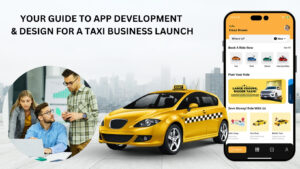
In a nutshell, the Blablacar Clone app focuses on ridesharing services. It allows the passenger to share the cost of the ride with a fellow passenger heading in the same direction. In this blog, you will learn how each process step works and its unique features effectively.
Introduction
Blablacar started as a ridesharing platform in 2006 before Uber launched its ride-hailing app. Therefore, it can be said that the success of Blablacar far precedes the digital age of connecting drivers with riders. However, the mobile application became known globally in Asia, Europe, and America.
With network connectivity, GPS, navigation devices, and e-transaction for payment, the Blablacar app works seamlessly without any problem. To understand the importance of each functionality, you must understand the tech stack involved in Blablacar Clone app development.
Blablacar Clone App: A Technical Stack Overview
Finding the right technical stack in the mobile app landscape is crucial for business expansion. It combines programming languages, frameworks, libraries, and server and UI tools as a ‘stack.’ Creating a scalable and secure app is a top priority for a ridesharing app. Therefore, the front-end and back-end languages must be finalized to keep the core features and services in mind.
Besides the front-end and back-end, selecting the correct server and hosting provider is essential to completing the app development process. Keep in mind that there are two development methods for mobile applications. However, a stable system architecture with the best compatible tech stack can easily cause countless trips to happen daily.
Therefore, the Blablacar Clone app follows the native app development approach instead of cross-app development. This choice is because native apps are best for App Store approval and incoming updates. They are also highly scalable, and they rarely crash. Even though building native apps takes more effort, it is a much more rewarding experience.
For starters, Java and Swift are the top choices for native programming languages for Android and iOS, respectively. Both of them come with their own development tools. For Java, Android Studio, and Swift, Xcode is the right tech stack. With the help of these development tools, your Blablacar Clone app will become more scalable in the long run.
Furthermore, the Blablacar Clone app tech stack also includes MongoDB, AngularJS, and NodeJS for web application development. Finally, Google Analytics and Amazon Web Services (AWS) complete the app development process by providing storage and database needs for on-demand apps.
Understanding the App Graphical Flow
Even the most advanced mobile applications need proper execution and strategy to flourish among the target audience. You can expect technology to take the lead only with the correct strategy. In the Blablacar Clone app, the more parts you add to your stack, the more complex their usage will be.
Here, the user app, website, and admin panel make the business run smoothly with robust security measures. Therefore, it is advised to simultaneously develop every interface to avoid similar repetitive feature additions. Now, let’s understand the Blablacar Clone app’s carpool service in detail:
Booking a Ride
After registering in the app, the passenger heads towards the home screen to add the source and destination address and date. Moreover, there is also the option to count the number of people traveling to pre-reserve seats. Now, by tapping the ‘Search’ button at the bottom of the screen, the user can see the list of available rides nearby. The user can tap on any of the available rides nearby to view the car’s details and the trip’s cost. There is also the presence of the driver’s information and contact details.
Making Payments
To move forward for booking confirmation, the user can tap on the ‘Continue’ button and make the payments using in-app wallets, cards, or cash. Here, the integration of the wallet feature is a unique initiative to help the user make emergency payments when bank servers are down. After making the payment, an in-app message confirms the booking process by displaying a confirmation message on the screen.
Driver Dispatch
After the payment method is successfully confirmed, the ride request is sent to the driver. Here, the driver is another user who accepts or declines the ride request depending on the route and cost of the trip. Afterward, as soon as the driver accepts the request, push messages confirm the booking request on the app.
Unique Features and UI/UX
It is critical to design every option and button exactly where the user needs them. Therefore, features like seeing the published rides, status or ETA, driver icon on the map, and countless other small details must be carefully addressed. For instance, when the driver arrives to pick up, the rider can see the car’s details, the driver’s name, and the time to reach, all on the same screen. Whereas, the driver can also see the location of the pickup and can change the ride’s status too.
Moreover, users who want to travel with other passengers can publish a ride by going to the “Publish” menu to add further information. Most of the Blablacar Clone apps work similarly and have seen a very high customer retention rate. Features like sending gift cards, multiple stopover points, and managing notifications and sounds are some of the essential features that make the Blablacar Clone app the best among competitors.
Choosing the Best Blablacar Clone App Development Services
To save time and money, you must not compromise with quality, search, and land smartly on an experienced app development service. To do this, see if the Blablacar Clone app has previously made similar ridesharing apps for others. If yes, check the testimonials in video format, not written. This will confirm their service’s legitimacy and allow them to move forward without any hassle.
For timeline and quotation, check the app demo and see which services you want and which ones to remove. Most app development firms offering clone apps are experts in re-branding the app per the buyer’s requirements. Suppose everything is done within the expected time. In that case, you can launch your ridesharing app business in under 1-2 weeks.
Conclusion
Ridesharing has been the most demanding service since the advent of taxicabs. Not only does this promote environmental sustainability, but it also reduces the trip cost for fellow passengers. Blablacar has gone through many business developments, but the big one was indeed the app’s creation. Having an app allowed them to scale globally by listening to the target audience’s feedback. You can achieve the same success if you opt for the intuitive and robust Blablacar Clone app today.







